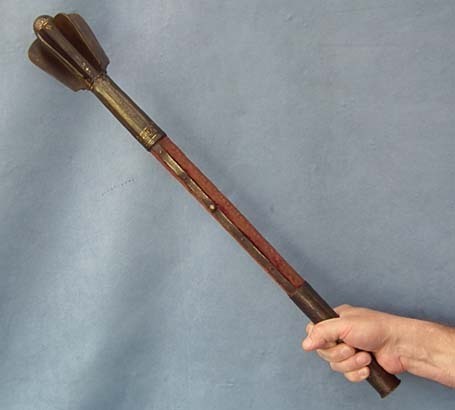Name: Gladius Hispaniensis
Used By: Romans
Date Used: 3rd-late 1st century BC
Dimensions: Blade:45-68cm (18-27in), Total-75-85cm (27-34in), 5cm width
Weight: 2 lb's (.8kg)
Material: Steel
Strengths:
-Pointed tip and length well suited for thrusting and penetration. Also, lacked curvature.
-Doubled-edges which made it well suited to cutting, as well, when situation called for it.
-Thrusts more deadly and likely to kill.
-Easier to manufacture as it required a simpler process, and hilt was made of natural materials.
Weaknesses:
-Somewhat heavier and longer than later versions.
-More expensive than later versions to produce.
-Excels against infantry, less effective against and for cavalry due to length.
Name: Mainz Gladius
Used By: Romans
Date Used: 1st century BC through time of game.
Dimensions: Blade-50-55cm, (20-22in), Total-65-70cm (25-28in), 7cm width
Weight: 1.5-2 lb's (.8kg)
Material: Steel
Strengths:
-Pointed tip and length even better suited to thrusting and penetration.
-Doubled-edges which made it well suited to cutting, as well, when situation called for it.
-Witdth of blade created more deadly thrusts.
-Easier to manufacture as it required a simpler process, and hilt was made of natural materials/smaller in size than earlier models.
Weaknesses:
-Heavier and longer than Pompeii version.
-More expensive than Pompeii.
-Excels against infantry, less effective against and for cavalry due to length.
Name: Pompeii Gladius
Used By: Romans
Date Used: 1st century BC through time of game.
Dimensions: Blade-45-50cm, (17-19in), Total-60-65cm (23-26in), 5cm width
Weight: 1.5 lb's (.7kg)
Material: Steel
Strengths:
-Shortest variation of the Gladii, triangular tip ideal for thrusting.
-Doubled-edges which made it well suited to cutting, as well, when situation called for it.
-Witdth of blade.
-Easiest/cheapest to manufacture.
-Lightest variation.
W eaknesses:
- Excels against sword-based infantry, less effective against and for cavalry due to length.
Name: Falcata
Used By: Iberians/Celts/Gauls
D ate Used: Throughout period of game
Dimensions: Length: 20in blade, 25in overall, Diameter: 6.5-7cm/2.5-3in
Weight: 3lb/1-1.5kg
Material: Iron/Steel
Strengths:
-Very strong steel for the ancient world.
-Single, forward-curving blade perfect for cutting blows.
-Allowed for the delivery of a very powerful blow that could smash armor and helmets.
-Unique grip allows for better handling and a steadier hold of the sword.
Weaknesses:
-Expensive and time consuming to produce.
-Not suited to thrusting blows, leaves user exposed.
-Gruesome effect and intimidating.
-More effective for cavalry than infantry, cutting less effective with shields.
Name: Kopis
Used By: Greeks/Persians/Italians
Date Used: Throughout period of game.
Dimensions: Length: 20-23in/11-15in Diameter: 6.5-7cm/2.5-3in
Weight: 2-3lb
Material: Iron
Strengths:
-Single, forward-curving blade perfect for cutting blows.
-Allowed for the delivery of a very powerful blow that could smash armor and helmets.
-Well suited for cavalry.
Weaknesses:
-Expensive and time consuming to produce.
-Not suited to thrusting blows, leaves user exposed.
-Gruesome effect and intimidating.
-More effective for cavalry than infantry, cutting less effective with shields.
Name: Makhaira/'Chopper'
Used By: Greeks/Persians/Italians
Date Used: Throughout period of game.
Dimensions: Length: 20-23in/11-15in Diameter: 6.5-7cm/2.5-3in
Weight: 2-3lb
Material: Iron
Strengths:
-Single, forward-curving blade perfect for cutting blows.
-Allowed for the delivery of a very powerful blow that could smash armor and helmets.
-Well suited for cavalry.
Weaknesses:
-Expensive and time consuming to produce.
-Not suited to thrusting blows, leaves user exposed.
-Gruesome effect and intimidating.
-More effective for cavalry than infantry, cutting less effective with shields.
N ame: Xiphos
U sed By : Greeks/Persians/Italians, similar designs throughout other regions.
Date Used: Throughout period of game.
Dimensions: Length: 20-23in, some as short as 12in, Diameter: 3in
Weight: 3lb
Material: Iron
Strengths:
-Doubled-edged, leaf shaped tip for cutting and thrusting.
-Well suited for infantry.
Weaknesses:
-More time consuming production than Gladius.
-Poorer quality iron.
Name: Labrys/Double-sided axe/Battle Axe
Used By: Everyone, but predominantly Celtic/Thracian/Eastern
Date Used: Throughout period of game.
Dimensions: Length: 12+in
Weight: varried 1-6lb
Material: Iron/bronze
Strengths:
-Powerful blow
-Armor penetrating
-Effective in close quarters
-Intimidation
Weaknesses:
-Short range
-A hacking weapon not well suited to disciplined fighting
Name: Falx, Short
Used By: Dacians/Thracians
Date Used: Throughout period of game.
Dimensions: Length: approx 16in blade, Total:38+in
Weight: varried
Material: Iron
Strengths:
-Armor penetrating - said to have cut through Roman armor and shields
-Cutting weapon, could hack off body parts
-Intimidation
-Reach
-Momentum of swing, great deal of force behind it
Weaknesses:
-Two handed weapon, so prevented use of shield
-A hacking weapon not well suited to formation
-Slash leaves user vulnerable
-One-sided blade with deep curve
Name: Rhomphaia
Used By: Thracians
Date Used: Throughout period of game.
Dimensions: Blade Length: 24-42in, approx 5ft (varried)
Weight: varried
Material: Iron, wooden shaft
Strengths:
-Armor penetrating
-Could hack off body parts, aided by the hook like blade
-Intimidation
-Great Reach
-Straight blade allowed for thrusting and tighter formations
Weaknesses:
-Two handed weapon, so prevented use of shield
-Straight blade less powerful than curved of the falx.
Name: Celtic Longsword
Used By: Celts
Date Used: Throughout period of game.
Dimensions: Blade Length: 27-31in, Total: 35-38, Diameter: 2in
Weight: 2-3lb's
Material: Iron/Steel
Strengths:
-Double-sided blade
-Reach
-At their best, high quality iron
Weaknesses:
-Length makes it better suited to cutting, which is how it was typically used.
-Variation in quality? Polybius gives accounts of Gallic swords bending on contact. Later studies have shown some of the swords do in fact have some bend if struck hard enough, if not to the extent described by Polybius.
Name: Celtic 'Short' Sword
Used By: Celts
Date Used: Throughout period of game.
Dimensions: Blade Length: approx 23in, Total: 30in, Diameter: 1.5-2in
Weight: 2lb's
Material: Iron/Steel
Strengths:
-Double-sided blade
-At their best, high quality iron
Weaknesses:
-Perhaps variation in quality |












cause im a cook in and commando here
keep up bro and if there is anything you would like to ask me tell it to my bro an steam and i will be updated







this is probably now the most full list of roman legions in order so you can see when they were raised and subsequently disbanded or destroyed.






the roster is huge though o.O

























)
